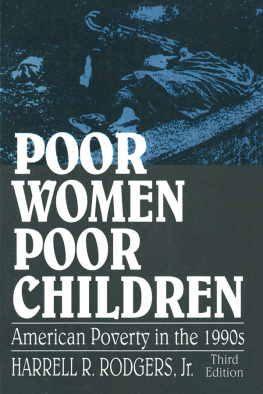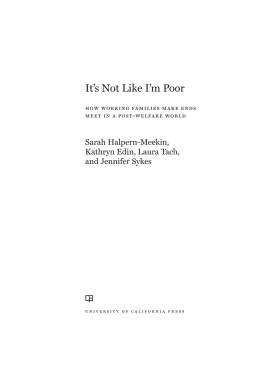Copyright 2015 by Kathryn J. Edin and H. Luke Shaefer
All rights reserved
For information about permission to reproduce selections from this book, write to Permissions, Houghton Mifflin Harcourt Publishing Company, 215 Park Avenue South, New York, New York 10003.
www.hmhco.com
Library of Congress Cataloging-in-Publication Data is available.
ISBN 978-0-544-30318-8
Jacket design by Martha Kennedy
Jacket photograph Don Nichols/Getty Images
e ISBN 978-0-544-30324-9
v1.0915
To our children,
Bridget, Kaitlin, Marisa, and Michael
Introduction
DEEP ON THE SOUTH SIDE of Chicago, far from the ever-evolving steel skyline of Americas third-largest city, sits a small, story-and-a-half white clapboard house clad in peeling paint. Thats where Susan Brown lives with her husband, Devin, and their eight-month-old daughter, Lauren, the three of them sharing the home with Susans grandmother, stepgrandfather, and uncle.
Wooden steps lead up to the age-worn threshold of an enclosed front porch, which slumps noticeably to the left. To enter the house, visitors must sidestep a warped, mold-stained plywood board that covers a large hole in the porch floor. The front door opens into a small, dark room furnished with a worn couch, a shaky wooden coffee table, and a leatherette easy chair with stuffing escaping from the left arm. Up and to the left, you can see a dark patch where the wall meets the ceiling. It seems like the spot is at best damp and at worst crumbling.
The air is dense. It is well above ninety degrees outside, but it feels even hotter inside the house. None of the windows open, although gaps between the frames and their casings let in a little bit of air. The carpeting in the front room has been discolored by footsteps and spills, and its matted surface feels a bit sticky. Where the carpet has worn away, there are the crumbling remains of black-and-white linoleum. Where the linoleum has worn through, there are the vestiges of once-fine hardwood floors.
At the back of the house, a giant 1980s-era refrigerator dominates a small kitchen outfitted with open shelving and a porcelain sink that may well be a century old. Inside the refrigerator, there are just a few bottles of baby formula that Susan has gotten from the Special Supplemental Nutrition Program for Women, Infants, and Children, called WIC. She says of baby Lauren, She gets WIC, but it dont last... They give her, like, seven cans, but its like the little cans. Otherwise, she says with a shrug, we dont have no food in the freezer right now. The fridge groans as it works to keep its mostly empty shelves cold.
In the heart of all the chaos that is inevitable when six people share a cramped, worn three-bedroom home, there is a small dining area sandwiched between the front room and the empty fridge in the back. In it sits a round dining table covered with a pristine white linen tablecloth, intricately embroidered around the edges. Four place settings are outfitted with gold-rimmed china and silver flatware. Four bright white napkins embellished with the same embroidery as the tablecloth have been carefully folded and placed in large crystal goblets. It is hard to imagine a more elegant table at which to share a meal. Yet here it sitsnever used, never disturbedaccompanied by a single chair.
This table harks back to a different era, a better time in the life of Susans family, when owning this house in this part of Chicago signaled the achievement of middle-class African American respectability. Before the economic anchors of this far South Side neighborhood closed downthe steel yards in the 1960s, the historic Pullman railway car company by the early 1980s, and the mammoth Sherwin-Williams paint factory in 1995Roseland was a community with decent-paying, stable jobs. It was a good place to raise your kids.
As the jobs left, the drugs arrived. It got worse, its changed, Susan says. Theres too much violence... unnecessary violence at that. Given what her family has been through, this is more than a bit of an understatement. Susans brother was shot in broad daylight just one block away. Her great-grandmother, in whose house they are living, has fled for a meager retirement out west. Susans family would like nothing more than to find another place to live, safer streets and a home that isnt crumbling around them. Yet despite all of its ills, this house is the only thing keeping Susan, Devin, and Lauren off the streets. They have spent the past few months surviving on cash income so low that it adds up to less than $2 per person, per day. With hardly a cent to their names, they have nowhere else to go.
Two dollars is less than the cost of a gallon of gas, roughly equivalent to that of a half gallon of milk. Many Americans have spent more than that before they get to work or school in the morning. Yet in 2011, more than 4 percent of all households with children in the worlds wealthiest nation were living in a poverty so deep that most Americans dont believe it even exists in this country.
Devin has a high school diploma. A clean record. Some work history. He spent most of the past year working construction gigs off the books for an uncle, until he got a temp job up in the northern suburbs. But that job lasted only a few months, and now hes gone half a year without finding another. After two months at home following the birth of baby Lauren, Susan began a frantic search for work, but it hasnt been going well. Ive been looking for jobs for forever, she says, clearly demoralized. Its gonna drive me crazy! Before she became pregnant with Lauren, Susan earned her GED and spent more than a year in community college, completing the remedial courses that would allow her to finally begin earning credits toward a certification in early childhood education. Yet she cant afford to return to college right now. Somebody has to find work.
Devin speaks with more confidence than Susan. He believes that any day now, things are bound to turn around. On his way to apply for a position at the Save-A-Lot grocery store nearby, his blue jeans are clean and crisp, his short-sleeved button-down shirt pressed. He has heard that there is an opening for part-time work in the produce department, paying $8.50 an hour. Despite six months of rejections, he is confident that hes got this one. At only twenty hours a week, it wont get his family above the poverty line, but its a start. Now if only Susan can find something. At least child care isnt a worry. Susans grandmother has had to leave her job to care for her husband, just home after a long hospitalization. She says that while shes nursing him at home, she can babysit Lauren if Susan finds a job.
Susan is sick of going hungry, sick of eating instant noodles morning, noon, and night. Shes tired of falling further and further behind on her bills, tired of being a freeloader in her own home. With no cash coming in, the whole family is in hock to Susans absentee landlord, her great-grandmother, who charges each of her tenants a modest rent to cover the property taxes and supplement her Social Security check. Susans uncle has been scraping together just enough to pay the utilities with his slim earnings from the occasional side job fixing cars in the backyard. The whole household depends on Susan and Devins food stamp benefits in order to eat. So as Susan goes about the work of caring for her baby and searching for a job, she is also learning another skillthe art of surviving on virtually nothing.
The Rise of $2-a-Day Poverty
By 2010, Kathryn Edin had spent more than twenty years canvassing poor communities all over the country, sitting with low-income parents at their kitchen tables or as they went about their work, talking about their economic lives. Beginning in the early 1990s, she and her colleague Laura Lein detailed the budgets of hundreds of the nations welfare recipients. They showed how, despite receiving a few hundred dollars in welfare benefits each month, these families still struggled to survive. Typically, they were able to cover only about three-fifths of their expenses with the cash and in-kind assistance they received from the welfare office. Each month, they had to scramble to bridge the large gap in their budgets. Yet on the whole, Edin and Lein found that by deploying grit and ingenuity, these families were usually able to stave off the most severe forms of material deprivation.
Next page









